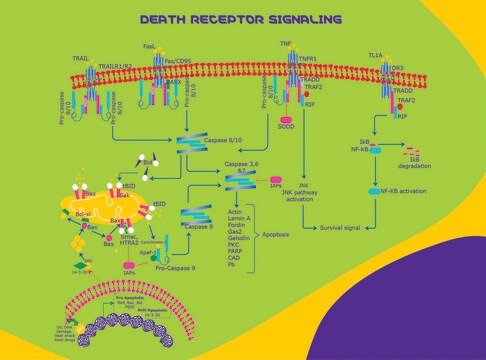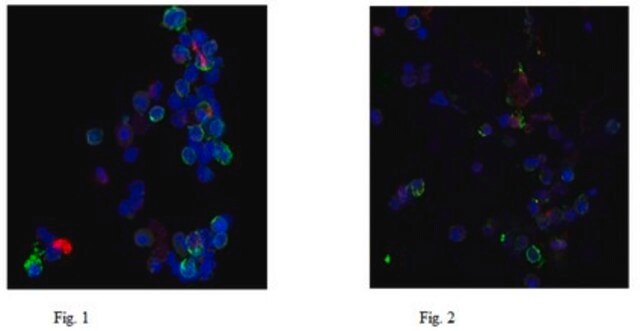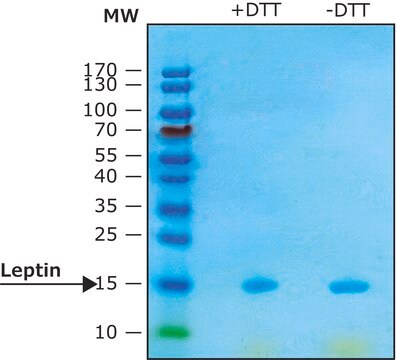T5694
TRAIL human
recombinant, expressed in NSO cells, >97% (SDS-PAGE), lyophilized powder
Synonym(s):
Apo2 Ligand, Apo2L, TL2, TNF-related apoptosis-inducing ligand
Sign Into View Organizational & Contract Pricing
All Photos(1)
About This Item
Recommended Products
biological source
human
Quality Level
recombinant
expressed in NSO cells
description
N-terminal 6X histidine-tagged extracellular domain
Assay
>97% (SDS-PAGE)
form
lyophilized powder
mol wt
24 kDa by SDS-PAGE
predicted mol wt ~21 kDa
technique(s)
cell culture | mammalian: suitable
impurities
endotoxin, tested
UniProt accession no.
storage temp.
−20°C
Gene Information
human ... TNFSF10(8743)
Looking for similar products? Visit Product Comparison Guide
Application
TRAIL human was used to induce cytotoxicity in A549, a human lung carcinoma cell line.
Biochem/physiol Actions
TNF-related apoptosis-inducing ligand (TRAIL) is a type II transmembrane protein that belongs to TNF family. It is present in both soluble as well as membrane-bound form and can induce rapid apoptosis of various transformed cell lines but not the normal cells. Additionally, the product can also induces apoptotic cell death in TRAIL-sensitive U343MGcells.
Type II transmembrane protein of the TNF superfamily. Ligand for apoptosis-inducing death receptors DR4 and DR5, decoy receptors DcR1 and DcR2, and osteoprotegerin. Approximately 28% amino acid sequence identity to FAS ligand. Human and mouse TRAIL share 65% sequence identity.
Physical form
Lyophilized from a 0.2 μm filtered solution in phosphate buffered saline containing 0.5 mg bovine serum albumin.
Analysis Note
Induces cytotoxicity in mouse L-929 cells in the presence of actinomycin D.
Storage Class Code
11 - Combustible Solids
WGK
WGK 3
Flash Point(F)
Not applicable
Flash Point(C)
Not applicable
Choose from one of the most recent versions:
Already Own This Product?
Find documentation for the products that you have recently purchased in the Document Library.
J Sträter et al.
Annals of the New York Academy of Sciences, 915, 162-170 (2001-02-24)
The tumor necrosis factor receptor (TNFR) family is a still-growing group of homologous transmembrane proteins, some of which bear an intracellular "death domain" and are able to directly mediate apoptosis. Apoptosis is induced upon trimerization of the receptors by their
Matthew J Coussens et al.
Journal of visualized experiments : JoVE, (58)(58), doi:10-doi:10 (2012-01-05)
RNA interference (RNAi) is an intrinsic cellular mechanism for the regulation of gene expression. Harnessing the innate power of this system enables us to knockdown gene expression levels in loss of gene function studies. There are two main methods for
W S Simonet et al.
Cell, 89(2), 309-319 (1997-04-18)
A novel secreted glycoprotein that regulates bone resorption has been identified. The protein, termed Osteoprotegerin (OPG), is a novel member of the TNF receptor superfamily. In vivo, hepatic expression of OPG in transgenic mice results in a profound yet nonlethal
X D Zhang et al.
FEBS letters, 482(3), 193-199 (2000-10-12)
Resistance of normal cells to tumour necrosis factor related apoptosis inducing ligand (TRAIL) induced apoptosis is believed to be mediated by expression of two decoy receptors. Here we show that the expression and localisation of TRAIL receptors (TRAIL-Rs) vary between
Ling Xu et al.
Oncology reports, 32(1), 318-324 (2014-05-21)
Gastric cancer cells are insensitive to tumor necrosis factor-related apoptosis-inducing ligand (TRAIL), and we recently showed that lipid raft-regulated epidermal growth factor receptor (EGFR) activation antagonized TRAIL-induced apoptosis. However, it is not clear whether caveolin-1, an essential structural constituent of
Our team of scientists has experience in all areas of research including Life Science, Material Science, Chemical Synthesis, Chromatography, Analytical and many others.
Contact Technical Service








